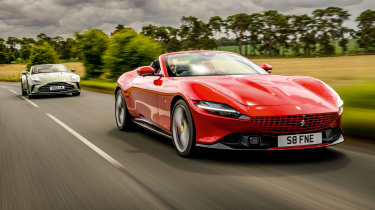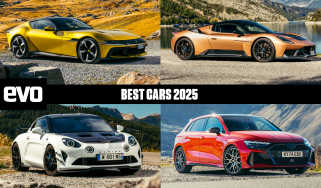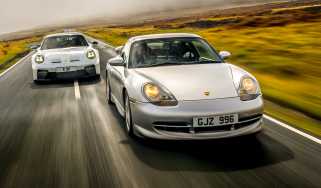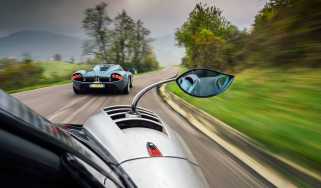Ferrari Roma Spider v Aston Martin Vantage Roadster: £200k V8 drop-tops go head-to-head
Aston Martin’s brand new Vantage Roadster takes on Ferrari’s acclaimed Roma Spider: British muscle versus Italian flair, but which will prevail?
The forecast is for heavy rain. Of course it is. After weeks of wall-to-wall sunshine that has bleached the lawn and almost tempted us into booking a summer holiday in Skeg Vegas, it’s going to chuck it down this afternoon. And the reason for the storm clouds rolling in from the west? We’ve had a cracking pair of convertibles delivered and today is the photoshoot.
I’m heading to the location in the brand new Aston Martin Vantage Roadster, launched a year after the coupe. Sometimes when you chop the roof off a car you’ve got used to seeing as a coupe it can look a bit awkward, but the Vantage Roadster (not Volante) looks great, roof up or down. After the trend for folding hard-tops, it’s refreshing to see a simple and neat, electrically powered fabric roof. Not only does this keep the weight gain down, it also means it’s quick to raise or lower. Push the button and it stows flush with the bootlid in just 6.8sec, making it the fastest powered roof on the market, says Aston. Roof up, its eight-layer construction makes it almost as refined as a hard-top, with notably superb wind noise refinement.
> The Ferrari Testarossa is officially back, and it’s a 1035bhp V8 hybrid
The Vantage Roadster was developed in parallel with the coupe and its aluminium structure features strategically placed strengthening panels to maintain integrity. Added to the powered roof, the total weight gain over the coupe is a reasonable 60kg, the mass slightly more rearward but still close to ideal at 49/51 front/rear. From the off, it feels just like the coupe, with hefty steering and an easy-going auto ’box, while its barrel-chested, twin-turbo V8 is every bit as vocal and it’s claimed that its 670bhp propels it to the same 3.6sec 0-62mph time and 202mph top speed. I’m guessing that’s with the roof up.
In some respects, the Ferrari Roma Spider is a natural rival. It has a base price of £210k to the Vantage’s £175k, also has a twin-turbo V8 boasting over 600bhp (611bhp to be precise), and claims very similar performance, its 0-62 two tenths quicker, its top speed a few mph down. It too has a fabric soft-top but one with a quite different look in profile, its lines reminiscent of a Porsche 911 convertible’s, the hood extending further rearwards and meeting the rising bodywork. That’s because it’s a 2+2 rather than a straight two-seater, and thus courts a slightly different audience.
The Roma is the child that ate its parent. It started life five years ago as a sleek coupe spun off the floorpan and running gear of the slightly frumpy 2+2 Portofino, the heavy rear end of which was designed around a folding hard-top. Now available as a 2+2 Spider, the Roma has displaced the Portofino in the Ferrari range, and while it has opted for a lighter, simpler roof, it’s more complicated than the Aston’s, stowing beneath a mechanised metal tonneau. Impressively, it encroaches on the boot space very little. In a race to raise or lower roofs, the Ferrari is a distant second, seemingly taking an age to drop its top because it’s still only halfway through when the Aston is done. And yet even with its roof stowed, the Roma offers more boot space than the Vantage, 255 versus 200 litres.
Another trick that the Roma pulls is fitting four seats, albeit two vestigial rear seats, within a wheelbase that’s actually fractionally shorter than the Aston’s. It’s also lighter, the conversion to convertible adding more weight at 84kg but to a lower starting kerb weight, the Roma also being built largely in aluminium. It’s 1654kg for the Spider versus 1730kg for the Roadster.
The Ferrari looks the lighter, more delicate car and sounds it too, the modest purr of its idling, flat-plane-crank 3.9-litre V8 drowned out by the rolling-thunder rumble of the Aston’s offset-crank, 4-litre V8 beside it. The muscular-looking Vantage drives like it looks; it feels initially very like the coupe, its steering quite hefty but nicely connected, its ride firm and instantly detailed. However, on country roads it soon becomes apparent that there’s been a small but significant shift in its character. The rear damping has been recalibrated for the changed weight distribution and, perhaps, structural rigidity – evidence of strengthening work is a large metal tube linking the suspension turrets in the boot – and it soon becomes apparent that the Roadster absorbs the lumps and bumps of everyday A- and B-roads better than the coupe, seeming to chamfer the edges off sharp bumps and flow over undulating surfaces with less fuss.
The optional carbon-ceramic brake set-up of this car has superb feel with lots of response right from the top of the pedal without being too bright, so you can get exactly what you want. Add that to the ride and the smooth eight-speed ZF auto and you have a convertible that potters about readily and also makes relaxed, confident progress. As mentioned, roof-up wind noise is very low for a soft-top, while roof down there’s not much turbulence in the cabin, in part thanks to the clear polycarbonate panel between the roll-over hoops. Generally, there’s more road noise than wind noise, unsurprising given the massive 21-inch wheels and tyres.
Of course, there’s a mighty engine ready to be unleashed by a solid prod of the throttle. Fully lit, the Vantage is sensationally rapid, feeling all of its 670bhp. Warm, dry roads see very little issue with traction in a straight line, vast 325-section rear Michelins hooking up and driving the car forward like a steam catapult. It feels good for the 3.6sec 0-62mph time and the roar from the tailpipes is even louder with the roof down.
There’s something a bit different about the Roadster’s dynamics versus the coupe, too. Maybe it’s a side effect of the change in damping and weight distribution, but when you turn into a tight corner carrying speed, the Roadster really wants to rotate. Yet while it swings keenly into corners, in the dry it still takes real effort to get it to break rear traction. I like this added dollop of natural agility; it makes you feel more involved with the process of threading down a tasty bit of road. Of course, it all changes when the rain comes down but we’ll get to that later.
From the moment you hop into it, the Ferrari feels quite different. Indeed, given how well matched they are on paper, they couldn’t feel much more different. The Aston’s seats are comfortable but a snug fit and so very supportive, while the Ferrari seat is firmer, the steering wheel thinner-rimmed and the cockpit architecture quite busy compared with the clean, simple lines of the Aston. The Roma’s facia is divided into two with what looks like an electronic notepad wedged into the cleft and, optionally, the passenger gets their own digital dashboard. That’s one of a huge list of options fitted to this test car, most of which are cosmetic and don’t materially change how the Roma drives but raise the as-tested price to almost £324k. The Vantage is £235k as tested.
There are many haptic buttons on the steering wheel that are hidden till lit and not that easy to find your way around, while the proxy shift selector gate, where you’ll find the toggle for reverse gear, is pretty fiddly but at least there’s now a light to show you’ve selected reverse. More impressively, there’s a pop-up panel that can be deployed in the absence of rear-seat passengers (maximum very young children) that quells cockpit turbulence so well that it allows the Roma to reach its top speed with the roof down.
There’s a muscular tautness to the way the Roma drives, the steering keen and direct and more detailed in feel, while even at a canter the shifts of the eight-speed DCT gearbox are smooth and snappy. Slightly at odds with this is the ride, which starts in Comfort mode and really does deliver what it says, the Roma moving with a plushness that’s pure GT. Pick up the pace, and while the V8 takes a little longer to come to the boil, it then revs higher and harder; the Vantage peaks at 6000rpm with a bassy whirr, while peak power in the Roma arrives at 5750rpm and is maintained all the way to 7500rpm, the note a smooth, tight, thrilling bark.
Switch up to Sport or Race and the delivery of the V8 gets a much harder edge to it, driving the Roma up the road with the same solid shove as the Aston, the DCT gearbox holding the gears and upshifting swiftly and seamlessly with a complementary tailpipe pop, making the Vantage’s auto feel sluggish. And yet even in Race, the Roma’s chassis remains supple, compliant, and while the steering isn’t sneeze-and-swerve sharp like in other Ferraris of the recent past, it is direct and responds obediently to small inputs, so the ride feels a little at odds with that and the energetic performance. Even guiding the Roma into sweeps, the steering feels bright, so with the ride relaxed beneath you it takes a bit of an effort and consciously soft hands to string a sequence of curves together sweetly. Also, the seats aren’t as supportive as the Aston’s so you find your weight shifting from bolster to bolster, taking up the slack as the car moves left and right.
The Roma does seem to be slightly traction-limited on its less chunky rear Bridgestone Potenza Sports, which alongside the Vantage look narrower and smaller than their 285/35 ZR20 dimensions. You get the feeling that engine torque is managed in the lowest gears. The mode strategy feels a little different from the norm too. Selecting Race you’d expect the gearbox to stay on high alert, but left in auto it mooches along in fifth or sixth, so to keep the Roma on the boil it’s best to use the large carbon paddles. Dynamically, it’s quite playful, quite agile. Keeping the revs up gives you consistent delivery to the rear so, TC off, you can load the car in a corner and then nudge the rear into scribing mild oversteer arcs.
As mentioned, the Vantage likes to rotate on entry but is more reluctant to break traction than the Roma. That all changes when the rain arrives and soaks roads that have been baked dry for weeks. Unexpectedly, the Aston is the more approachable car on these slippery surfaces. Creep up to the limit of front grip in a corner and when you feel the onset of slip, a gentle prod of the throttle will jink the rear out and a steady right foot will hold the angle. Of course, you can build up to it by gradually dialling down the scalable traction control. Same corner, same approach in the Roma and, although it feels a little less grippy than the Aston in the dry, it’s a bit snappier over the limit in the wet, perhaps because you need more revs to make the torque and break traction.
At heart the Vantage and Roma are quite different cars. If you really need a convertible with +2 seating there’s only one choice, but if you’re simply looking for an entertaining, high-performance convertible, you could deduce how each will feel and drive just by looking round them while they idle. On its massive wheels the Aston looks beefy, the archetypal brute-in-a-suit, and even at idle its V8 sounds thunderous. The Ferrari looks sharper, more delicate, and its flat-plane V8 idles with a light, hungry purpose. And so it is.
In many ways, the Roma is the precision tool, the clarity and response of its steering, the crisp, smooth and seamless efficiency of its dual-clutch gearbox and the wail of its high-revving V8 combining for a sharp sense of purpose. And yet even with the manettino twisted to its sportiest setting, the ride remains supple, cosseting. I understand the Roma Spider is the new Portofino and so has more of a GT brief, but there’s surely the bandwidth in the damping for firmer control in Race that would bring the ride into line with the rest of the car, without compromising comfort in other modes.
The Vantage is a big character. Not as sharp shifting, not as delicate through the wheel and not as smooth-riding as the Roma, but a hugely likeable car with a sharp, classy interior and good looks. It’s a well-rounded, refined car with big performance and engaging, capable dynamics and, unexpectedly, it has a notably more supple ride than the Vantage coupe, which is a real plus. Add in the fact that it’s impressively refined hood-up, and there isn’t much reason not to have this instead of the coupe. I wouldn’t hesitate.
Of the two, which V8 drop-top would get your vote?
| Ferrari Roma Spider | Aston Martin Vantage Roadster | |
| Engine | V8, 3855cc, twin-turbocharged | V8, 3998cc, twin-turbocharged |
| Power | 611bhp @ 5750-7500rpm | 670bhp @ 6000rpm |
| Torque | 560lb ft @ 3000-5750rpm | 590lb ft @ 2000-5000rpm |
| Weight | 1654kg | 1730kg |
| Power-to-weight | 375bhp/ton | 393bhp/ton |
| Tyres | Bridgestone Potenza Sport | Michelin Pilot Sport S 5 |
| 0-62mph | 3.4sec | 3.6sec |
| Top speed | 199mph | 202mph |
| Basic price | £210,838 | £175,000 |
This story was first featured in evo issue 337.




